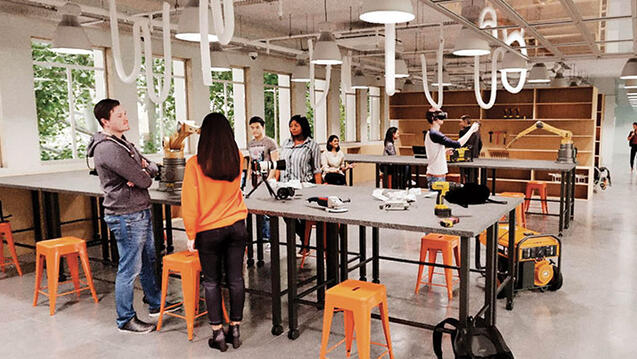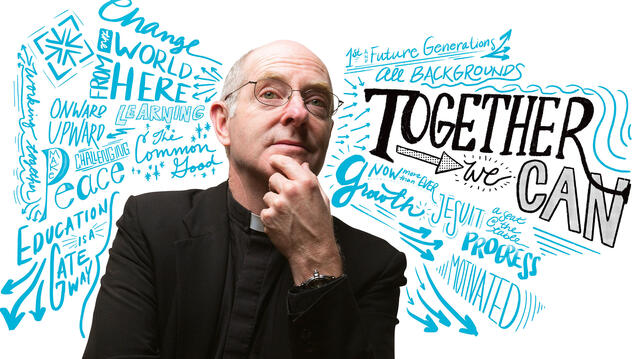

The Possible Dream
When a new television show, Paid Off, offers winners cash to pay their student loans — and a beer company pledges $10 million to the same cause — it’s clear that education debt has become a national crisis.
Americans are $1.5 trillion deep in student loan debt, and millions of former students are in default.
But, USF Provost Don Heller tells us, that’s not the whole picture. Heller says that while $1.5 trillion in debt — which includes both undergraduate and graduate student borrowing — is a frightening figure, another factor to consider is the return on investment of a college education. People who graduate from college are generally better off socially and economically than people who don’t — and the median salary for recent USF graduates, $62,300, is one of the highest in the nation.
“The people who get into trouble are those who borrow but never complete a degree,” says Heller. “For the vast majority of students, the value of a USF degree is going to allow them to pay back their loans.”
Nevertheless, student debt can be a major stressor for undergraduate Dons and their families, who sometimes have to make difficult choices, like choosing a lucrative but unfulfilling career, forgoing study abroad opportunities, or working multiple jobs during college. Assistant Vice Provost Mary Booker hears stories like these every day as the head of the Office of Student Financial Services, which distributes financial aid and scholarships. Booker is the daughter of Mississippi sharecroppers and a first-generation college student. She knows all too well the hardships — and the payoff — of investing in a college education.
USF Magazine spoke with Heller (also a first-generation college student) and Booker about the cost of a USF degree, how students can afford it, and the university campaign to raise $100 million for scholarships and financial aid.

Many parents and students get sticker shock when learning the price of a USF education: $65,692 for tuition, housing, and meals for 2019–20. Why so expensive?
Heller: There are a lot of factors to contend with: recruiting and paying faculty and staff, building state-of-the-art classrooms and labs, maintaining facilities. Plus, as prices across the economy rise, so do ours.
I should emphasize, though, that even though the tuition sticker price has been going up, we’ve also been increasing financial aid. Financial aid and scholarships to students are the second-largest line item in USF’s budget, after faculty and staff salaries, and they have been increasing at a faster rate than tuition.

First and foremost, my scholarship provided me with opportunity. My parents are both immigrants who each had the formal educational equivalent of a middle school degree, and despite that they are the most intelligent people I know. They instilled in my sisters and me a deep appreciation for learning. Watching the sacrifices they made every day to make sure we had access to education gave me a strong motivation to succeed in school, and that success led me to USF.”
Maria Zamora ’21 International studies and political science double-major | Research Fulbright applicant
The important thing for parents and students to look at is not just what’s happening with the sticker price, but what’s happening to the net price — the amount students pay after scholarships and grants. The average net price at USF is $35,000.
That’s still a lot of money.
Booker: $35,000 is still a lot of money, but our students graduate with debt that’s lower than the national average, and our alumni are in the top 10 percent for earnings among all four-year colleges and universities around the country. The investment students are making in their education here is being rewarded when they go out and get jobs.
Part of USF’s mission is to recruit first-generation and lower-income students. How are these students doing?
Heller: About a third of our students are first-generation and a quarter to a third have been awarded Pell Grants — federal grants reserved for low- and moderate-income families. These first-gen and low-income students are the ones who historically are at risk for dropping out and not graduating. But we’ve supported these students, and they graduate at very good rates compared to national averages.
So is a USF education affordable for these students and for others — say, a middle-class family with several college-age children?
Heller: Yes, through the scholarships and financial aid we offer, and through loans, a USF education is affordable for most of our applicants.
Booker: While we don’t want our students taking on an excess of loans, I think some debt allows students to invest in their experience — they’ll be invested in graduating and then in giving back to the institution.
Though most of our applicants will be able to afford to go here, we do have students who enroll but then have to leave for financial reasons.
Booker: About 15 percent of students leave the university before graduating, for various reasons. I’d say about a third of those are leaving because of finances.
I was laid off due to a corporate reorganization while completing my application to the USF MBA program. The scholarship I received allowed me to obtain a graduate degree and remain debt-free — a gift for which I couldn’t be more grateful. My time in the program gave me the opportunity to reflect on the layoff and understand the organizational politics that caused it, and how to be better prepared for similar possibilities in the future. I’m prepared now to take the team I manage at Tray.io to the next level of success.”
Phil Burch ’19 MBA candidate | Project marketing manager, Tray.io
Mary, who are the students who come to your office for assistance?
Booker: About half of the university’s students have to dip into a private loan or a Parent PLUS Loan, a federal loan available to parents. These are the students we’ll often hear from — usually in their sophomore year, when they face the expense of living off campus, or junior year, when they’re trying to figure out how to make it across the finish line and graduate.

“My scholarship has allowed me to work as a research assistant and focus more on the AWM chapter at USF, instead of having to pick up extra shifts at my part-time job. I assist Professor Stephen Devlin, director of USF’s master’s in data science program, in researching networks and ranking theory. The experience is preparing me for postgraduate education, as I’m planning to obtain my doctorate in mathematics. After that, I hope to work as a mathematical statistician at a health-related organization like the Centers for Disease Control and Prevention. I was always taught that ‘empowered women empower women,’ and I want to spend at least part of my career giving girls the confidence to pursue career paths they might not have considered open to them.”
Molly Creagar ’19 Mathematics major | Cofounder, Association for Women in Mathematics (AWM) at USF
My office reassesses their financial aid packages to see if they’re eligible for more, or helps them manage their budgets or find loans. But these students face tough choices that affect their academic experience. Can they study abroad? Can they take an unpaid internship for the summer? We’d like all of our students to have a full experience while they’re here.
USF’s new campaign aims to raise $100 million to fund financial aid. Who will this benefit?
Booker: We’d like to help current students, particularly in situations where a parent has lost a job or had to take another job at lower pay.
We’d also like to offer more aid to prospective students. This essentially takes the finance question off the table, so we can shift the conversation to focus on other important topics like what we offer in terms of academics, staff and faculty support, and Jesuit values.
Student debt isn’t the only crisis of higher education. Because there are fewer college-age Americans, schools around the country are competing for a shrinking pool of students. Some colleges are even shutting down, right?
Booker: If you look at schools that are closing, many gave great financial aid but didn’t do well in selling the value proposition: What makes their institution unique. Our goal is to put the value proposition front and center.
Heller: We have a lot of advantages. We’re relatively large among private institutions, we’re in a vibrant city, and we offer a distinctive education rooted in Jesuit values. Plus we’re on solid financial footing, largely because of the work we’ve done so far in this campaign, and because we’ve closely monitored, and cut when appropriate, our expenses.
That said, we have to remain competitive. Even though I believe a USF education is affordable for the vast majority of our students, we want to make it more affordable. Increasing financial aid will go a long way toward building our longevity as an institution.
What should donors expect if they choose to support USF?
Heller: First and foremost, we want them to know that we will be conscientious and responsible stewards of their funds. We ensure that all of their gifts will be used to directly bolster the mission of the university and will be used in a way that aligns with those aspects of our mission they are most interested in supporting.
Booker: Agreed. A big part of our effort is also to help donors know that small gifts do add up and make a difference.


